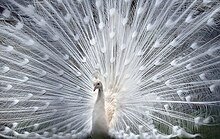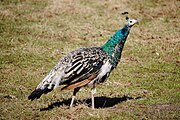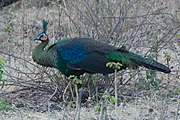Pavo (bird)
| Pavo Temporal range: Late Miocene to present
| |
|---|---|

| |
| Indian peacock (Pavo cristatus) displaying its tail | |
| Scientific classification | |
| Domain: | Eukaryota |
| Kingdom: | Animalia |
| Phylum: | Chordata |
| Class: | Aves |
| Order: | Galliformes |
| Family: | Phasianidae |
| Tribe: | Pavonini |
| Genus: | Pavo Linnaeus, 1758 |
| Type species | |
| Pavo cristatus (Indian peafowl) Linnaeus, 1758
| |
| Species | |

Pavo is a genus of two species in the pheasant family. The two species, along with the Congo peafowl, are known as peafowl.
Taxonomy[edit]
The genus Pavo was introduced in 1758 by the Swedish naturalist Carl Linnaeus in the tenth edition of his Systema Naturae.[1] The genus name is the Latin word for a peacock.[2] The type species is the Indian peafowl (Pavo cristatus).[3]
Species[edit]
The genus contains two species.[4]
| Common name | Scientific name and subspecies | Range | Size and ecology | IUCN status and estimated population |
|---|---|---|---|---|
| Indian peafowl | Pavo cristatus Linnaeus, 1758 |
South Asia; introduced elsewhere
|
Size: Habitat: Diet: |
LC
|
| Green peafowl | Pavo muticus Linnaeus, 1766 |
Southeast Asia
|
Size: Habitat: Diet: |
EN
|
Fossil record[edit]
- Pavo bravardi (Bravard's peafowl) (Early – Late Pliocene) – Gallus moldovicus, sometimes misspelt moldavicus, may be a junior synonym[5]
- Gallus aesculapii, a Late Miocene – Early Pliocene "junglefowl" of Greece, may also have been a peafowl[5]
In the Pliocene on the Balkan Peninsula, Bravard's peafowl coexisted with ptarmigans (Lagopus sp.)[6] Peafowl were widespread on the Balkan Peninsula and in Southeastern Europe until the end of the Pliocene.[7]
References[edit]
Wikimedia Commons has media related to Pavo.
- ^ Linnaeus, Carl (1758). Systema Naturae per regna tria naturae, secundum classes, ordines, genera, species, cum characteribus, differentiis, synonymis, locis (in Latin). Vol. 1 (10th ed.). Holmiae (Stockholm): Laurentii Salvii. p. 156.
- ^ Jobling, James A. (2010). The Helm Dictionary of Scientific Bird Names. London: Christopher Helm. p. 294. ISBN 978-1-4081-2501-4.
- ^ Peters, James Lee, ed. (1934). Check-List of Birds of the World. Vol. 2. Cambridge, Massachusetts: Harvard University Press. p. 133.
- ^ Gill, Frank; Donsker, David; Rasmussen, Pamela, eds. (July 2021). "Pheasants, partridges, francolins". IOC World Bird List Version 11.2. International Ornithologists' Union. Retrieved 23 August 2021.
- ^ a b Mourer-Chauviré, Cécile (1989). "A peafowl from the Pliocene of Perpignan, France" (PDF). Palaeontology. 32 (2): 439 – via The Palaeontological Association.
- ^ Boev, Zlatorar (1998). "Peafowls (g. Pavo Linnaeus, 1758) and Ptarmigans (g. Lagopus Brisson, 1760): an [sic] unique coexistance in North Bulgaria over 3 m. y. ago". - Biogeographia, Nuova Serie, Siena, 19 – 1997: 219-222. doi:10.21426/B6110058
- ^ Boev, Z. 2002. Fossil record and disappearance of peafowl (Pavo Linnaeus) from the Balkan Peninsula and Europe (Aves: Phasianidae). – Historia naturalis bulgarica, 14: 109-115.








